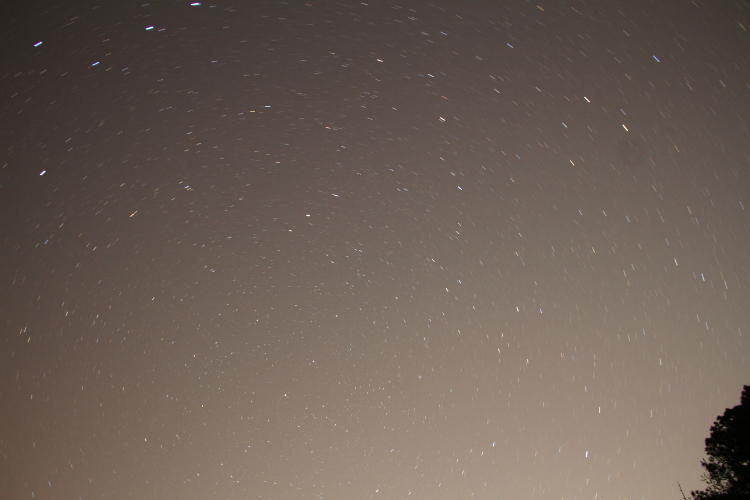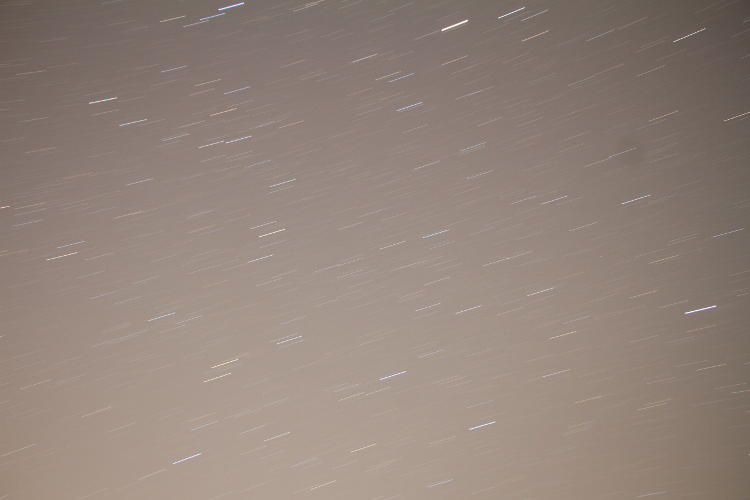So, I went out Monday night/Tuesday morning to try and catch something for the Lyrids meteor shower that we are currently undergoing. For once, we had ideal conditions, or as ideal as I can possibly achieve in this location: no moon, clear skies, and I traveled down to Jordan Lake to get the darkest skies possible within, oh, thirty kilometers or so (which isn’t all that dark, because it sits too close to three cities.) It was after 1 AM, so a better time for such things.
Results? Zilch nada. I saw two distinct meteors in over an hour of shooting, a far cry from the “10-15 possible,” and neither was within the wide field of view of the camera. Examining the frames afterward carefully, I found nothing distinct, and only two tiny streaks that may have been ridiculously small and brief meteors. Not a great show.

This is a four-minute exposure aimed northward, and you can see for yourself the lack of streaks not in a circular pattern that would signify a meteor. The circular-patterned streaks are merely stars rendered by the rotation of the earth. I could have had them longer and more distinct with a longer exposure, but as you can see, the light pollution was already making the frame a bit bright, and longer would have made that worse, washing out even more stars and certainly all but the brightest meteors.
By the way, this frame contains Polaris, the North Star – it’s the brighter star about 1/4 up from the bottom, 1/3 in from the left side, and at higher resolution than this, the curves noticeably have this as their axis. I feel obligated to point out that Polaris is not the brightest star in the sky – an awful lot of people believe this for some reason, and will get hopelessly lost in the woods some night trying to orient on Sirius or Venus, which might take them entirely in the opposite direction. In my frame here, the brighter stars at upper left are part of Ursa Major, the big bear or the big dipper, whatever you like to call it – I didn’t quite get enough of it in the frame. And yes, I had some kind of smudge or spot on the sensor or lens (upper right darker spot.)
Now, here’s something that I did capture. Maybe. Hard to tell, and hard to prove, I think.

This is full-frame, and pretty effectively 90° away from the previous – not horizontally, but vertically, over the top, because this is showing the plane of the ecliptic, the ‘waist’ stars that sit directly over the equator. These always show the most streaking because they’re aligned with the greatest angle of the earth’s rotation, but you can also see that there’s two sets of curves: the upper set curving upwards have the axis of Polaris, which sits (almost) directly over the North Pole, and the lower set curving downward have the axis of the South Pole of the planet, which does not conveniently have a star perched overhead (no, the Southern Cross only points south, but none of the stars represent the pole itself, and anyway it’s well out of sight below the horizon at this latitude.) But all that isn’t the curiosity, just kind of the lead-in. Let’s take a full-resolution look at a portion of the same frame.

You can see that focus might have been a little bit better – the camera was manually focused on a distant radio tower beacon before re-aiming – but there are several anomalous single points in the frame, and notably all just in this one section. This is very close to the plane of the ecliptic, yet doesn’t appear to be on it to me – a little below. But no stars should have presented a single point of light in a ten-minute exposure, and nothing else should have either. Except perhaps geostationary satellites.
Geostationary satellites have an orbit that matches the rotation of the earth, so in effect they ‘hover’ over one particular spot. Mostly these are communication satellites, so the earth-based antennas can remain pointed in one direction, but some weather satellites and earth-observing satellites fit the bill too. In order to have the orbital velocity match the angular rotation of the earth, they have to be way out there – like 36,000 kilometers, which is nearly three times the diameter of the planet itself (I’ll expand on this further down.) This is a hell of a lot farther than the Hubble Space Telescope (HST) or the International Space Station (ISS,) both of which pass horizon to horizon overhead, when visible, within a few minutes.
I did noise removal on this frame, so none of these should represent any, though the one right in the middle of this frame still looks like a likely candidate; all others are too diffuse to be such. And this really does represent the only place in the frame where such things are showing. It would generally take a long exposure to even see any such satellites, since their distance makes them exceptionally small targets, and this time at night they should be catching only peripheral sunlight scattered through the atmosphere around the edges of the planet. Should they be clustered this close together? Dunno. Maybe, when I’m bored, I’ll sit down and see if these seem to match up to any known satellites.
The one good thing about trying to photograph such things is, there’s no need to compensate for the earth’s rotation, so the exposure can be ridiculously long with only a long lens or a telescope, no tracking method is needed, unlike for just about any other celestial object. The hard part is, knowing where to be pointed in the first place. I might have to play with this sometime later on. For now, we’ll just consider it a possible explanation for those specks.
[Orbital mechanics: So, gravity is always trying to draw stuff towards earth, and there’s no point where it becomes too weak to have an effect – hell, the moon is held in check by it and it’s 384,000 kilometers away. But an object can achieve an orbital stability, essentially ‘freefall’ and weightlessness (or microgravity, which is more accurate) by moving to the side, so the draw of gravity only redirects it in an arc that circles the planet. Low Earth Orbit stuff like the Hubble Space Telescope (568 km up) and the International Space Station (408 km) need to be moving laterally at a pretty good clip to maintain their altitude, and this is in the realm of 27,000 kph. If they went slower, gravity would slowly draw them closer, and if they went faster they’d move further off. For geostationary satellites, their speed is around 11,000 kph – gravity is weaker that far out, so the velocity doesn’t have to be as high, and the balance between speed and distance makes them maintain a position over a single spot on earth, or revolve as fast as the earth rotates – same thing.
And just as a bit of trivia, such satellites were never launched by the Space Shuttle Orbiters, which stayed in the LEO range and couldn’t ever get that far out. It takes multi-stage rockets boosters to place these kinds of satellites in their orbits.]




















































